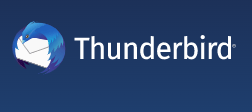Every young hacker who volunteers for an OpenSource Project wants to put “their mark” on the thing, that has to be where Thunderbird threading came from. For over a decade we have not had threading and we have adjusted to it. The sad part of this is if you click on the first collapsed message in the thread, instead of expanding the thread, it opens all of them. I can’t tell you how to fix that bug from the menu, but I can tell you how to turn off threading. No config editor hacking required.
MAC users are screwed! Go play with your one-button mouse.
Right click in the space next to the “Inbox” tab.

Hidden Menus
I will never understand this fascination with “hidden menus” that has wormed its way into software development. The entire point of the GUI was to make software accessible to the user. In the days of DOS and every other Operating System where we only had a command line “expert friendly” was the law of the land. Digital Equipment Corporation set out to change that by having one word every user could remember, HELP. That got you into a help system where you could navigate around. All help for all system tools and applications was there. DOS didn’t have that. Linux never came close. There were man pages and info pages and lots of things with no help at all making the entire experience “expert friendly.”
Stop hiding menus people! There is nothing cool or sexy about it.
I’ve written about Thunderbird before, even Mutt and a few other email clients. Email software seems to be devolving. Automatically opening messages is a ghastly security breach waiting to happen.
The Rest of the Solution
Once you can see the menu, click on “View”

That will expose a menu with the “Sort by” option. As you can see, at the bottom of that menu is where you choose Threaded, Unthreaded, and “Grouped By Sort”.
It’s moments like this that I wish I could find a snippet from the All in the Family episode where Archie’s female neighbor got a job driving the forklift at the loading dock. She wanted to know where she could submit her suggestions to improve the loading docks.
“Well, you write them down on a small piece of paper and, you know the men’s turlet?”
“Yes.”
“We’ve got three of them in there.”
